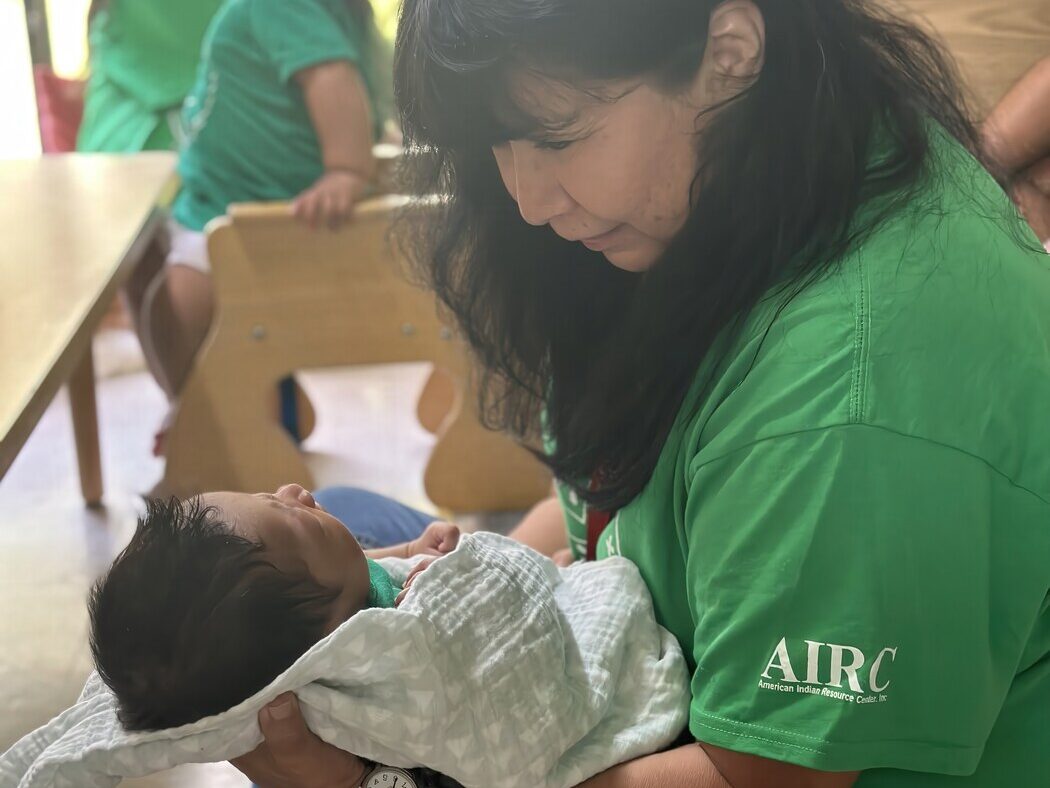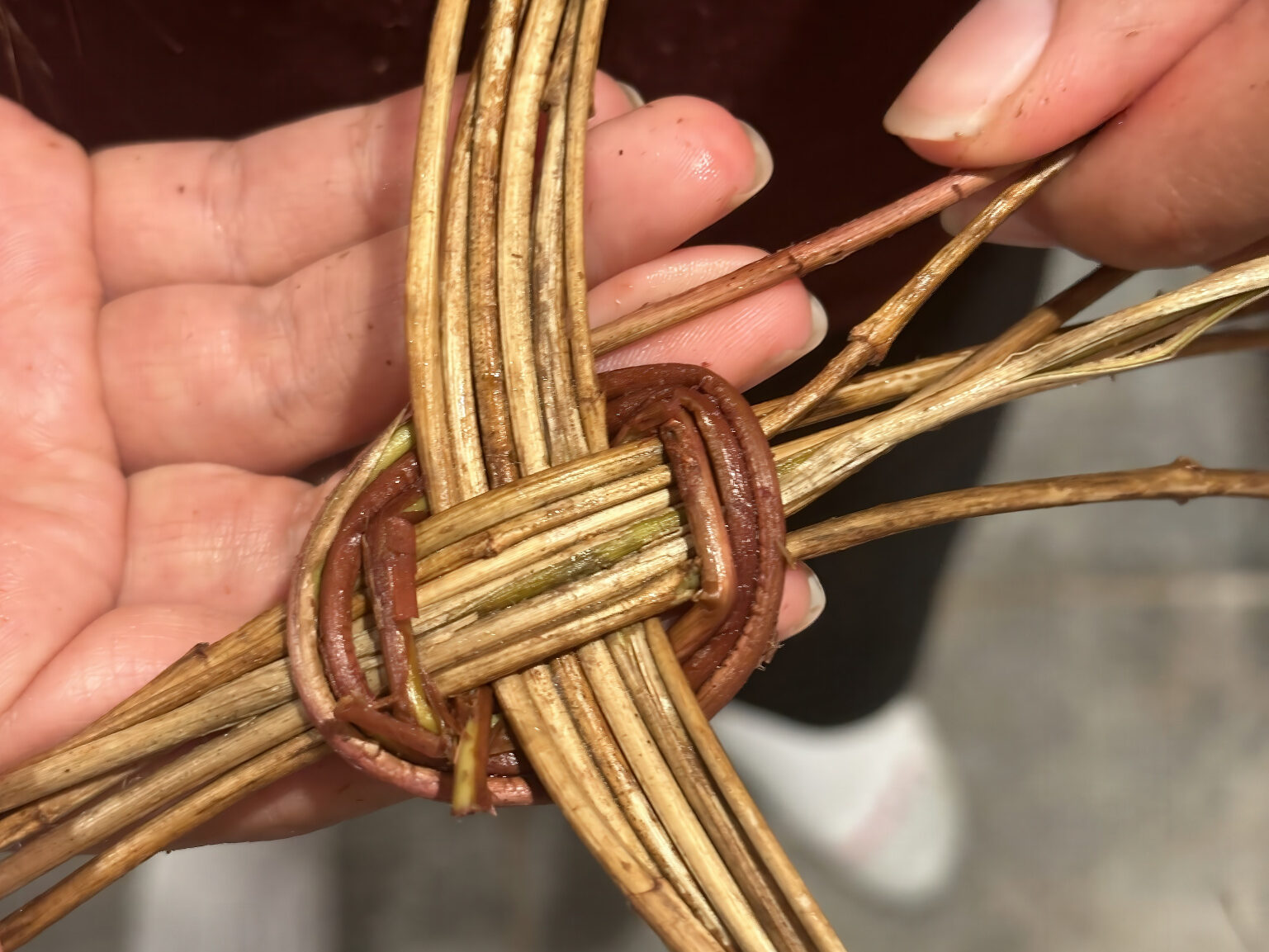ᏃᏨᏛᏁᎰ
What We Do
Little Cherokee Seeds is a program of the American Indian Resource Center, Inc in which Cherokee mothers and babies are immersed in the Cherokee language and culture. Our goals are to:
- Create Cherokee speakers from infancy
- Revitalize traditional Cherokee cultural practices to be passed to the next generation.
We are not creating speakers, we are creating Cherokees.Ꮭ ᏣᎳᏊᎢᎦ ᎠᏂᏬᏂᏍᎩ ᏱᎨᏎᏍᏗ ᎠᏂᏣᎳᎩ ᎨᏎᏍᏗ
Phyllis SixkillerᏥᎫᏫ
ᎦᏬᏂᎯᏍᏗLanguage
Language Acquisition Method
Our lofty goal is that children at Little Cherokee Seeds will become first language speakers by being immersed in an environment that mimics how our first language speakers learned the Cherokee language. This includes creating a family and community environment in which children observe and participate in daily Cherokee practices using only the Cherokee language. Learning occurs using traditional Cherokee beliefs, values, and cultural practices.

We use natural conversation to create a functional, living language – not a memorized language.ᎣᏣᏗᏍᎪ ᏂᎬᏩᏍᏛ ᎣᎩᏬᏂᎯᏍᏗ ᎣᏦᏢᏍᎪ ᏳᎵᏍᏙᏗ, ᎬᏃᏓ ᎦᏬᏂᏍᏗ Ꮭ ᎬᏁᎳᎩ ᏱᎩ ᎦᏬᏂᎯᏍᏗ ᏗᎾᏕᏲᎲᏍᎩ
LCS TeachersᏗᎾᏕᏲᎲᏍᎩ

ᎧᏃᎮᎸᎯTradition
We do not use a standardized, pre-planned curriculum but participate in activities during the day that follow the seasonal and development seasons of the natural environment around us (e.g., seasonal rounds). This allows us to connect with our natural relatives in several ways. First, we pay attention to the natural environment and you will often hear, “Are the (wisi, sohi, svgi) ready?” and the follow-up question is, “Have you seen them? Where did you see them?.” The last question is have you talked to____ (mother, uncle, cousin)?” These are a series of questions that are often discussed that centers us on what is happening in our world now, who has seen it, and what connections do we need to make to collect or gather the seasonal items.
We are losing Cherokee speakers everyday and it is so important to keep the Cherokee language and culture going. With this program I believe we will create Cherokee speakers.ᏧᎩᏨᏅᏓ ᏕᎩᏲᏏ ᎠᏂᏣᎳᎩ ᎠᏂᏬᏂᏍᎩ, ᎠᎴ ᎤᎵᏍᎨᏛ ᎢᎦᏯᎢᏒ ᎠᏍᏆᏂᎪᏙᏗ ᏣᎳᎩ ᎦᏬᏂᎯᏍᏗ ᎠᎴ ᎢᎩᎲ ᏱᎦᏛᏁᎵᏓᏍᏗ. ᎯᎠ ᎣᎦᏙᏢᏒ ᎠᏬᎯᏳ ᏙᏓᏲᏦᏢᏂ ᏣᎳᎩ ᎠᏂᏬᏂᏍᎩ ᏧᎩᏨᏅᏓ ᏕᎩᏲᏏ ᎠᏂᏣᎳᎩ ᎠᏂᏬᏂᏍᎩ, ᎠᎴ ᎤᎵᏍᎨᏛ ᎢᎦᏯᎢᏒ ᎠᏍᏆᏂᎪᏙᏗ ᏣᎳᎩ ᎦᏬᏂᎯᏍᏗ ᎠᎴ ᎢᎩᎲ ᏱᎦᏛᏁᎵᏓᏍᏗ. ᎯᎠ ᎣᎦᏙᏢᏒ ᎠᏬᎯᏳ ᏙᏓᏲᏦᏢᏂ ᏣᎳᎩ ᎠᏂᏬᏂᏍᎩ.
Bobbie Gail SmithᎤᎬᏫᏱ
Here is a sample of some of the activities that we engage in during each season.
| Fall | Winter | Spring | Summer |
|---|---|---|---|
| Gather/cook mushrooms | Winter sowing | Onions (pick, clean) | Elderberry tea |
| Make Kanvchi | Canning cabbage | Seeds (plant, transplanting) | Medicinal plant walk |
| Collect Chinquapin | Pickling sunchokes | Labeled seeds | Picked mulberries |
| Collect Hickory Nuts | Quilts (tacking, hemming) | Worked in garden (weeding, planting) | Pick strawberries |
| Collect possum grapes | Sewing | Walking in woods and gathered poke | Cleaned/froze strawberries and mulberries for jam |
| Make baskets | Sewing skirts | Cooked poke | Butterfly walk |
| Coil reed | Embroidery | Looked for morels | Canning cabbage |
| Walnut dye-dye reed | Aprons | Outdoor cooking | Collect Crawdads |
| Buck brush basket | Loom weaving observation | Collect wild onions, Cook them | Harvest corn, husk corn, braid and dry corn |
| Flat reed sifter and baskets | Making cornhusk dolls | Punched holes in tin cans for firing clay beads | Making jewelry |
| Collect clay | Beading | Beading (clay bead necklaces, rolling, firing) | Twining |
We use our lifeways as a curriculum, we don’t have to teach it. They just become it.Ꮭ ᏧᎾᏕᏠᏆᏍᏗ ᎣᎦᏙᏢᏒ ᏱᎩ. Ꮭ ᏧᎾᏕᏠᏆᏍᏗ ᏕᎧᏅᏑᎸ ᏱᏙᎪᏢᎭ. ᏄᏍᏛ ᎣᏤᎲᎢ ᎣᏨᏗᎰᎢ. ᏦᎦᏕᏲᏗ Ꮭ ᏗᎨᏲᏗ ᏱᎨᏐᎢ. ᎾᏍᎩᏃ ᏫᎾᎾᎵᏍᏗᏍᎪᎢ.
LCS TeachersᏗᎾᏕᏲᎲᏍᎩ
